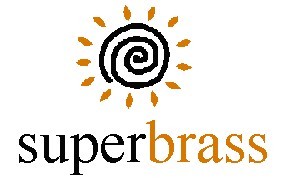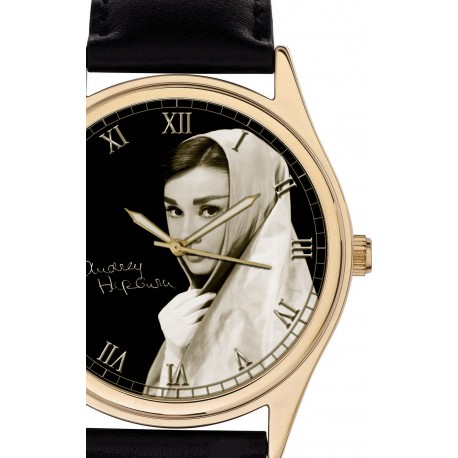No products
Latest Graphic Art Watches
New products
-

Seth vs Osiris, Ancient Egypt Metallic Original Art Solid Brass Collectible Mens' Watch
40 mm solid brass casing in gold finish with stainless steel back...
$ 121.44 -

Chinese Traditional Good Luck Dragon Art Gold Medallion Solid Brass Men's Watch
40 mm solid brass casing in gold finish with stainless steel back...
$ 129.59 -

English Colours Fire-Breathing Dragon Ancient Parchment Fantasy Art Brass Watch
40 mm solid brass casing in gold finish with stainless steel back...
$ 137.74 -

Ancient Blue Fire-Breathing Dragon Parchment Art Solid Brass Mens Dress Watch
40 mm solid brass casing in gold finish with stainless steel back...
$ 137.74 -

Golden Dragon Metallic Art Solid Brass Collectible Men's Fantasy Good Luck Watch
40 mm solid brass casing in gold finish with stainless steel back...
$ 121.44
Beautiful Audrey Hepburn Hollywood Memorabilia 40 mm Collectible Watch
IQ-N6DC-0H76
New product
- Audrey Hepburn Wrist Watch
- Premium Citizen 2040 quartz movement.
- 40 mm large size heavy brass case.
- Rubberized Leather band.
- Unique Collectible Limited Edition Handmade Watches.
- Can be provided in smaller ladies' 30 mm size or in silver case upon email request (use "Contact Us" link above)
More info
Audrey Hepburn (/ˈɔːdri ˈhɛpˌbɜːrn/; born Audrey Kathleen Ruston; 4 May 1929 – 20 January 1993) was a British actress. Recognised as a film and fashion icon, Hepburn was active during Hollywood's Golden Age. She was ranked by the American Film Institute as the third-greatest female screen legend in Golden Age Hollywood and was inducted into the International Best Dressed List Hall of Fame. Born in Ixelles, a district of Brussels, Hepburn spent her childhood between Belgium, England and the Netherlands, including German-occupiedArnhem during the Second World War where she worked as a courier for the Dutch resistance and assisted with fundraising. In Amsterdam she studied ballet with Sonia Gaskell, before moving to London in 1948 to continue her ballet training with Marie Rambertand perform as a chorus girl in West End musical theatre productions. She spoke several languages, including English, French,Dutch, Italian, Spanish, and German.[1]
Following minor appearances in several films, Hepburn starred in the 1951 Broadway playGigi after being spotted by French novelistColette, on whose work the play was based. She shot to stardom for playing the lead role inRoman Holiday (1953), for which she was the first actress to win an Academy Award, a Golden Globe and a BAFTA Award for a single performance. The same year Hepburn won aTony Award for Best Lead Actress in a Play for her performance in Ondine. She went on to star in a number of successful films, such asSabrina (1954), The Nun's Story (1959),Breakfast at Tiffany's (1961), Charade (1963),My Fair Lady (1964) and Wait Until Dark(1967), for which she received Academy Award, Golden Globe and BAFTA nominations. Hepburn won a record three BAFTA Awards for Best British Actress in a Leading Role. In recognition of her film career, she was awarded the Lifetime Achievement Award from BAFTA, Golden Globe Cecil B. DeMille Award, the Screen Actors Guild Life Achievement Award, and the Special Tony Award. She remains one of the few people who have won Academy, Emmy, Grammy, and Tony Awards.
Hepburn appeared in fewer films as her life went on, devoting much of her later life toUNICEF. Although contributing to the organisation since 1954, she worked in some of the poorest communities of Africa, South America and Asia between 1988 and 1992. She was awarded the Presidential Medal of Freedom in recognition of her work as a UNICEF Goodwill Ambassador in December 1992. A month later, Hepburn died of appendiceal cancer at her home in Switzerland at the age of 63.
Early life
Family and early childhood (1929–1938)
Hepburn was born Audrey Kathleen van Heemstra Ruston on 4 May 1929 at number 48 Rue Keyenveld in Ixelles, a municipality in Brussels, Belgium.[2] Her father, Joseph Victor Anthony Ruston (1889–1980), was a British subject born in Auschitz, Bohemia, Austra-Hungary,[3][a]to Anna Ruston (née Wels), of Austrian descent,[4] and Victor John George Ruston, of British and Austrian descent.[5] After World War I, Joseph was appointed British consul in the Dutch East Indies, and prior to his marriage to Hepburn's mother he had been married to Cornelia Bisschop, a Dutch heiress.[3][6] Although born Ruston, he later double-barrelled the surname to the more "aristocratic" Hepburn-Ruston, mistakenly[5] believing himself descended fromJames Hepburn, third husband of Mary, Queen of Scots.[6]
Hepburn's mother, Baroness Ella van Heemstra (1900–1984), was a Dutch aristocrat and the daughter of Baron Aarnoud van Heemstra, who served as mayor of Arnhem from 1910 to 1920, and as Governor of Dutch Suriname from 1921 to 1928. Ella's mother was Elbrig Willemine Henriette, Baroness van Asbeck (1873–1939), who was a granddaughter of jurist Count Dirk van Hogendorp.[7] At age nineteen, Ella had married Jonkheer (Esquire) Hendrik Gustaaf Adolf Quarles van Ufford, an oil executive based in Batavia, Dutch East Indies, where they subsequently lived.[8] They had two sons, Jonkheer Arnoud Robert Alexander Quarles van Ufford (1920–1979) and Jonkheer Ian Edgar Bruce Quarles van Ufford (1924–2010), before divorcing in 1925.[6][8][9]
Hepburn's parents were married in Batavia in September 1926.[8] At the time, Ruston worked for a trading company, but soon after the marriage, the couple relocated to Europe, where he began working for a loan company. After a year in London, they moved to Brussels, where he had been assigned to open a branch office.[8][10] After three years spent travelling between Brussels, Arnhem, The Hague and London, the family settled to the suburban Brussels municipality of Linkebeek in 1932.[8][11] Hepburn's early childhood was sheltered and privileged.[8] As a result of her multinational background and travelling with her family due of her father's job,[12][b] she learned to speak five languages: Dutch and English from her parents, and later French, Spanish, and Italian. To strengthen her English, Hepburn was sent to a boarding school in Elham, Kent when she was five years old.[8][13]
Hepburn's parents were members of the British Union of Fascists in the mid-1930s,[14] with her father becoming a sincere Nazi sympathiser.[15] Joseph left the family abruptly in 1935 and divorced Ella in 1938;[8] his increasing radicalism,[8] allegations by his father-in-law that he was financially irresponsible,[8] infidelity,[16] and alcoholism[8] have variously been cited as causes for the break-up of the marriage. Ella was given Hepburn's custody, and although Joseph —who had settled in London— was allowed visitation rights, he did not use them.[3][8]Hepburn later stated that her father's disappearance from her life was "the most traumatic event of my life".[8] In the 1960s, she renewed contact with him after locating him in Dublinthrough the Red Cross; although he remained emotionally detached, Hepburn supported him financially until his death.[17] Following the divorce, Ella began making more frequent visits to Kent.[8]
Experiences during World War II (1939–1945)[edit]
After Britain declared war on Germany in September 1939, Hepburn's mother relocated her daughter back to Arnhem in the hope that, as during World War I, the Netherlands would remain neutral and be spared a German attack. While there, Hepburn attended the Arnhem Conservatory from 1939 to 1945. She had begun taking ballet lessons during her last years at boarding school, and continued training in Arnhem under the tutelage of Winja Marova, becoming her "star pupil".[8] After the Germans invaded the Netherlands in 1940, Hepburn adopted the pseudonym Edda van Heemstra, because an "English-sounding" name was considered dangerous during the German occupation. Her family was profoundly affected by the occupation, with Hepburn later stating that "had we known that we were going to be occupied for five years, we might have all shot ourselves. We thought it might be over next week ... six months ... next year ... that's how we got through".[8] In 1942, her uncle, Otto van Limburg Stirum (husband of her mother's older sister, Miesje), was executed in retaliation for an act of sabotage by the resistance movement; while he had not been involved in the act, he was targeted due to his family's prominence in Dutch society.[8] Hepburn's half-brother Ian was deported to Berlin to work in a German labour camp, and her other half-brother Alex went into hiding to avoid the same fate.[8]
"We saw young men put against the wall and shot, and they'd close the street and then open it and you could pass by again...Don't discount anything awful you hear or read about the Nazis. It's worse than you could ever imagine."[8]
After her uncle's death, Hepburn, Ella and Miesje left Arnhem to live with her grandfather Baron Aarnoud van Heemstra in nearby Velp.[8] During this time, Hepburn participated in the Dutch resistance, delivering messages and packages, and performing ballet in clandestine fundraising events.[8] In addition to other traumatic events, she witnessed the transportation of Dutch Jews toconcentration camps, later stating that "more than once I was at the station seeing trainloads of Jews being transported, seeing all these faces over the top of the wagon. I remember, very sharply, one little boy standing with his parents on the platform, very pale, very blond, wearing a coat that was much too big for him, and he stepped on to the train. I was a child observing a child."[18]
After the Allied landing on D-Day, living conditions grew worse and Arnhem was subsequently destroyed during Operation Market Garden. During the Dutch famine that followed in the winter of 1944, the Germans blocked the resupply routes of the Dutch people's already-limited food and fuel supplies as retaliation for railway strikes that were held to hinder German occupation. Hepburn and many others resorted to making flour out of tulip bulbs to bake cakes and biscuits;[15][19] she developed acute anæmia, respiratory problems and edema as a result of malnutrition.[20] The van Heemstra family was also seriously financially affected by the occupation, during which many of their properties, including their principal estate in Arnhem, were badly damaged or destroyed.[21] The Allies liberated the Netherlands in May 1945, with United Nations Relief and Rehabilitation Administration beginning the distribution of food and other essentials.[8][22]
Entertainment career[edit]
Ballet studies and early acting roles (1945–1952)[edit]
After the war ended in 1945, Hepburn moved with her mother and siblings to Amsterdam, where she began training ballet under Sonia Gaskell, a leading figure in Dutch ballet, and Russian Olga Tarassova.[23] As the family's fortunes had been lost during the war, Ella supported them by working as a cook and housekeeper for a wealthy family.[24] Hepburn made her film debut in 1948, playing an air stewardess in Dutch in Seven Lessons, an educational travel film made by Charles van der Linden and Henry Josephson.[25] Later that year, she moved to London to take up a ballet scholarship with Ballet Rambert, which was then based in Notting Hill.[26][c] She supported herself with part-time work as a model, and dropped "Ruston" from her surname. After she was told by Rambert that despite her talent, her height and weak constitution (the after-effect of wartime malnutrition) would make the status of prima ballerina unattainable, she decided to concentrate on acting.[27][28][29]
While Ella worked menial jobs to support them, Hepburn appeared as a chorus girl[30] in theWest End musical theatre revues High Button Shoes (1948) at the London Hippodrome, and Cecil Landeau's Sauce Tartare (1949) and Sauce Piquante (1950) at the Cambridge Theatre. During her theatrical work, she took elocution lessons with actor Felix Aylmer to develop her voice.[31] After being spotted by a casting director while performing in Sauce Piquante, Hepburn was registered as a freelance actress with the Associated British Picture Corporation. She appeared in minor roles in the 1951 films One Wild Oat, Laughter in Paradise, Young Wives' Tale and The Lavender Hill Mob, before being cast in her first major supporting role in Thorold Dickinson's The Secret People (1952), in which she played a prodigious ballerina, performing all of her own dancing sequences.[32]
Hepburn was then offered a small role in a film being shot in both English and French, Monte Carlo Baby (Nous Irons à Monte Carlo) (1951), which was filmed in Monte Carlo. Incidentally, French novelist Colette was at the Hôtel de Paris in Monte Carlo during the filming, and decided to cast Hepburn in the title role in the Broadway play Gigi.[33] Hepburn went into rehearsals having never spoken on stage and required private coaching.[34] When Gigiopened at the Fulton Theatre on 24 November 1951, she received praise for her performance, despite criticism that the stage version was inferior to the French filmatisation.[35] Life called her a "hit",[35] while The New York Times stated that “her quality is so winning and so right that she is the success of the evening".[34] She also received a Theatre World Award for the role.[36] The play ran for 219 performances, closing on 31 May 1952,[36] before going on tour which began 13 October 1952 in Pittsburgh and visited Cleveland, Chicago, Detroit,Washington D.C. and Los Angeles before closing on 16 May 1953 in San Francisco.[37]
Roman Holiday and stardom (1953–1960)[edit]
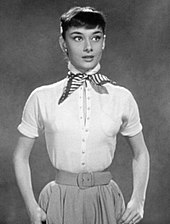
Hepburn had her first starring role in Roman Holiday (1953), playing Princess Anne, a European princess who, while escaping the reins of royalty, falls in love with an American newsman (Gregory Peck). Its producers initially wantedElizabeth Taylor for the role, but director William Wyler was so impressed by Hepburn's screen test that he cast her instead. Wyler later commented, "She had everything I was looking for: charm, innocence, and talent. She also was very funny. She was absolutely enchanting and we said, 'That's the girl!'"[38] Originally, the film was to have had only Gregory Peck's name above its title, with "Introducing Audrey Hepburn" beneath in smaller font. However, Peck suggested to Wyler that he elevate her to equal billing so that her name appeared before the title and in type as large as his: "You've got to change that because she'll be a big star and I'll look like a big jerk."[39][40]
The film was a box office success, and Hepburn gained critical acclaim for her portrayal, unexpectedly winning a Academy Award for Best Actress, a BAFTA Award for Best British Actress in a Leading Role, and a Golden Globe Award for Best Actress – Motion Picture Drama in 1953. In his review in The New York Times, A. H. Weiler wrote that Hepburn's Princess Anne "is a slender, elfin and wistful beauty, alternately regal and childlike in her profound appreciation of newly-found, simple pleasures and love. Although she bravely smiles her acknowledgement of the end of that affair, she remains a pitifully lonely figure facing a stuffy future."[41]
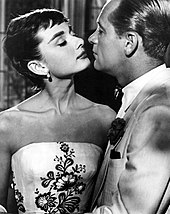
Hepburn was signed to a seven-picture contract withParamount with 12 months in between films to allow her time for stage work.[42] She was featured on the 7 September 1953 cover of TIME magazine, and also became noted for her personal style.[43] Following her success in Roman Holiday, Hepburn starred in Billy Wilder's romanticCinderella-story comedy Sabrina (1954), in which wealthy brothers (Humphrey Bogart and William Holden) compete for the affections of their chauffeur's innocent daughter (Hepburn). For her performance, she was nominated for the 1954 Academy Award for Best Actress while winning the BAFTA Award for Best Actress in a Leading Role the same year. Bosley Crowther of The New York Times stated that she is "a young lady of extraordinary range of sensitive and moving expressions within such a frail and slender frame. She is even more luminous as the daughter and pet of the servants' hall than she was as a princess last year, and no more than that can be said."[44]
Hepburn also returned to the stage in 1954, playing a water spirit who falls in love with a human in the fantasy play Ondine on Broadway. A New York Times critic commented that "somehow Miss Hepburn is able to translate [its intangibles] into the language of the theatre without artfulness or precociousness. She gives a pulsing performance that is all grace and enchantment, disciplined by an instinct for the realities of the stage". Her performance won her the 1954 Tony Award for Best Performance by a Leading Actress in a Play the same year she won the Academy Award for Roman Holiday. Hepburn is therefore one of three actresses to receive the Academy and Tony Awards for Best Actress in the same year (the other two are Shirley Booth and Ellen Burstyn).[45] During the production, Hepburn and her co-star Mel Ferrer began a relationship, and were married on 25 September 1954 in Switzerland.

Although she appeared in no new film releases in 1955, Hepburn received the Golden Globe for World Film Favorite that year.[46] Having become one of Hollywood's most popular box-office attractions, she went on to star in a series of successful films during the remainder of the decade, including her BAFTA- and Golden Globe-nominated role as Natasha Rostova in War and Peace (1956), an adaptation of the Tolstoy novel set during the Napoleonic wars with Henry Fonda and husband Mel Ferrer. In 1957 she exhibited her dancing abilities in her debutmusical film, Funny Face (1957) wherein Fred Astaire, a fashion photographer, discovers a beatnik bookstore clerk (Hepburn) who, lured by a free trip to Paris, becomes a beautiful model. The same year Hepburn starred in another romantic comedy, Love in the Afternoon, alongside Gary Cooper and Maurice Chevalier.

Hepburn played Sister Luke in The Nun's Story(1959), which focuses on the character's struggle to succeed as a nun, alongside co-star Peter Finch. The role produced a third Academy Award nomination for Hepburn and earned her a second BAFTA Award. A review in Variety read, "Hepburn has her most demanding film role, and she gives her finest performance", while Films in Review stated that her performance "will forever silence those who have thought her less an actress than a symbol of the sophisticated child/woman. Her portrayal of Sister Luke is one of the great performances of the screen."[47] Reportedly, she spent hours in convents and with members of the Church to bring truth to her portrayal, stating that she "gave more time, energy and thought to this than to any of my previous screen performances."[48]
Following The Nun's Story, Hepburn received a lukewarm reception for starring with Anthony Perkins in the romantic adventure Green Mansions (1959), in which she played Rima, a jungle girl who falls in love with a Venezuelan traveler,[49] and The Unforgiven (1960), her only western film, in which she appeared opposite Burt Lancaster and Lillian Gish in a story of racism against a group of Native Americans.[50]
Breakfast at Tiffany's and continued success (1961–1967)[edit]

Hepburn next starred as New York call girl Holly Golightly in Blake Edwards's Breakfast at Tiffany's(1961), a film loosely based on the eponymousTruman Capote novella. Capote disapproved of many changes that were made to sanitize the story for the film adaptation, and would have preferred forMarilyn Monroe to have been cast in the role, although he also stated that Hepburn "did a terrific job".[51] The character is considered one of the most iconic in American cinema, and a defining role for Hepburn.[52] The dress she wears during the opening credits is considered an icon of the twentieth century and perhaps the most famous "little black dress" of all time.[53][54][55][56] Hepburn stated that the role was "the jazziest of my career"[57] yet admitted: "I'm an introvert. Playing the extroverted girl was the hardest thing I ever did."[58] She was nominated for an Academy Award for Best Actress for her performance.

The same year, Hepburn also starred in William Wyler's controversial drama The Children's Hour(1961), in which she and Shirley MacLaine played teachers whose lives become troubled after a student accuses them of being lesbians.[52] Due to the social mores of the time, the film and Hepburn's performance went largely unmentioned, both critically and commercially. Bosley Crowther of The New York Times opined that the film "is not too well acted" with the exception of Hepburn who "gives the impression of being sensitive and pure" of its "muted theme",[59] while Variety magazine also complimented Hepburn's "soft sensitivity, mar-velous [sic] projection and emotional understatement" adding that Hepburn and MacLaine "beautifully complement each other".[60]
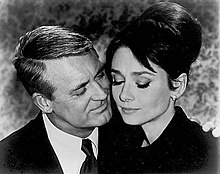
Hepburn next appeared opposite Cary Grant in the comic thriller Charade (1963), playing a young widow pursued by several men who chase the fortune stolen by her murdered husband. 59-year-old Grant, who had previously withdrawn from the starring male lead roles in Roman Holiday andSabrina, was sensitive about his age difference with 34-year-old Hepburn, and was uncomfortable about the romantic interplay. To satisfy his concerns, the filmmakers agreed to change the screenplay so that Hepburn's character romantically pursued his.[61]The film turned out to be a positive experience for him, stating that "All I want for Christmas is another picture with Audrey Hepburn."[62] The role earned Hepburn her third and final competitive BAFTA Award and another Golden Globe nomination. Critic Bosley Crowther was less kind of her performance, stating that "Hepburn is cheerfully committed to a mood of how-nuts-can-you-be in an obviously comforting assortment of expensive Givenchy costumes."[63]
Hepburn reteamed with her Sabrina co-star William Holden in Paris When It Sizzles (1964), ascrewball comedy in which she played the young assistant of a Hollywood screenwriter, who aids his writer's block by acting out his fantasies of possible plots. Its production was troubled by a number of problems. Holden unsuccessfully tried to rekindle a romance with the now-married Hepburn, and his alcoholism was beginning to affect his work. After principal photography began, she demanded the dismissal of cinematographer Claude Renoir after seeing what she felt were unflattering dailies.[64] Superstitious, she also insisted on dressing room 55 because that was her lucky number and required that Givenchy, her long-time designer, be given a credit in the film for her perfume.[64] Dubbed "marshmallow-weight hokum" by Variety upon its release in April,[65] the film was "uniformly panned"[64] but critics were kinder to Hepburn's performance, describing her as "a refreshingly individual creature in an era of the exaggerated curve".[65]
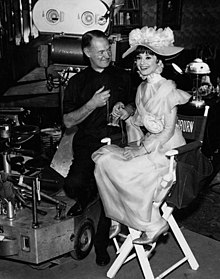
Hepburn's second film of 1964 was George Cukor's film adaptation of the stage musical My Fair Lady, released in November. Soundstage wrote that "not since Gone with the Wind has a motion picture created such universal excitement as My Fair Lady",[45] yet Hepburn's casting in the role ofCockney flower girl Eliza Doolittle sparked controversy. Julie Andrews, who had originated the role in the stage show, had not been offered the part because producer Jack L. Warner thought Hepburn or Elizabeth Taylor were more "bankable" propositions.[66] Hepburn initially asked Warner to give the role to Andrews but was eventually cast.[66]Further friction was created when, although non-singer Hepburn had sung in Funny Face and had lengthy vocal preparation for the role in My Fair Lady,[66] her vocals were dubbed by Marni Nixon as the songs were not written for her vocal range.[67][68] Hepburn was initially upset and walked out on the set when informed.[66][d]
The press further played up the fabricated rivalry between Hepburn and Andrews, when the latter won an Academy Award for Mary Poppins at the 37th Academy Awards (1964) but Hepburn was not even nominated, despite My Fair Lady's accumulation of eight out of a possible twelve awards. Regardless, critics greatly applauded Hepburn's "exquisite" performance.[68] Crowther wrote that "the happiest thing about [My Fair Lady] is that Audrey Hepburn superbly justifies the decision of Jack Warner to get her to play the title role."[67]Gene Ringgold of Soundstage also commented that "Audrey Hepburn is magnificent. She is Eliza for the ages",[45] while adding, "Everyone agreed that if Julie Andrews was not to be in the film, Audrey Hepburn was the perfect choice."[45]
As the decade carried on, Hepburn appeared in an assortment of genres including the heist comedy How to Steal a Million (1966) where she played the daughter of a famous art collector, whose collection consists entirely of forgeries. Fearing her father's exposure, she sets out to steal one of his priceless statues with the help of a man played by Peter O'Toole. It was followed by two films in 1967. The first was Two for the Road, a non-linear and innovative British dramedy that traces the course of a couple's troubled marriage. Director <a href="https://en.wikipedia.org/wiki/Stanley_Donen" title="Stanley Do
Reviews
No customer reviews for the moment.
